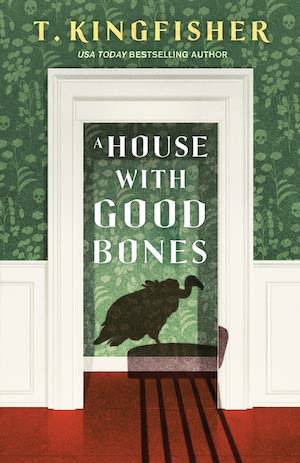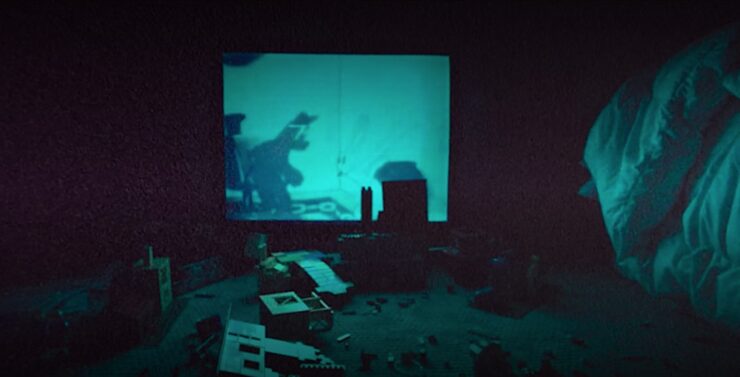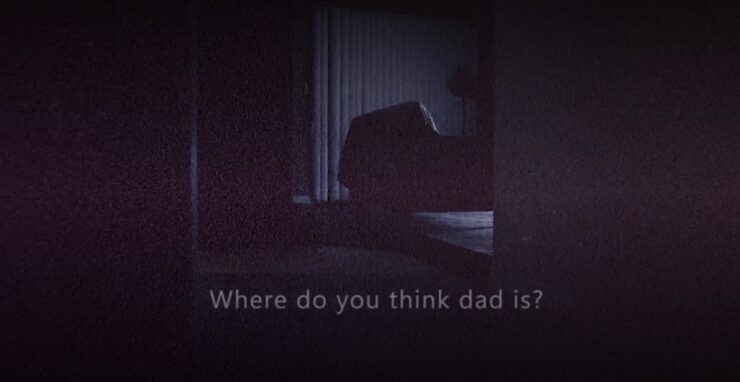Skinamarink is slow cinema masquerading as found-footage horror. The film’s inciting incident is of two children waking up to find that their father—and all the exterior windows and doors to their house—are gone. They’re left to fend for themselves in a home that has turned hostile, trapped in the dark with no way in or out, with only a TV and toys for company. Like most slow cinema, the film consists of long, quiet takes in which not much happens on screen; the genre invites contemplation and reflection. There isn’t much plot beyond the premise. The most common reading of the film is that it’s about child abuse, heavy fare for a difficult movie—but my own experience with Skinamarink had to do with another sense of powerlessness: that of childhood fear of the Rapture.
For the uninitiated: the Rapture is a piece of apocryphal American Christian doctrine, invented in the 1800s and most recently popularized by the Left Behind books and movies. (Editor’s note: and by a couple of Marvel movies.) The Rapture holds that true believers will be caught up into heaven at the second coming of Christ, leaving everyone else on earth to undergo tribulation. The doctrine hinges on a handful of Bible verses, divorced from context and from the original Greek. It’s not a widely accepted teaching in Christianity, but it is most common in American Evangelicalism. I was never explicitly taught to believe in the Rapture, at home or at church. My family didn’t read the Left Behind books. I’m not sure that we ever explicitly subscribed to the theology. But the belief was in the water, and when I was young, it loomed perpetually in my mind. I remember being unable to find my mother in the grocery store, looking carefully down every aisle I went by, hoping to find her and not just a pile of clothes that she might have left behind. Deep down I thought the fear was irrational, but I wasn’t sure if it was because I didn’t really believe in the Rapture, or if it was because I’d already prayed to ask Jesus into my heart, and that meant I too should have been raptured alongside my mother. The thing about faith is that there’s no way to know for certain, and in a denomination that deals so strongly in surface-level appearances of certainty, a shadow of doubt can cast deep fear.
Buy the Book


A House With Good Bones
Skinamarink could be called a Rapture movie purely on the basis that the children’s parents have mysteriously disappeared, leaving their offspring to contend with horrors that they do not understand, and cannot possibly resist. Most of the churches that teach the Rapture also teach that children are completely innocent until they reach an “age of accountability.” The children in Skinamarink, especially the elder of the two, are likely on the cusp of that age, and therefore in danger of hell should they sin without repenting. The house they live in is hell already. They have no control, and very little agency; they have little identity beyond their names, and the camera never shows their faces. They’re old enough to eat cereal and work the TV, but they’re young enough that their personalities have not yet fully been shaped.
The film underlines this sense of formlessness and powerlessness by framing the children from behind as they move about the house. The camera lurks near the carpet, contemplating toys scattered across the floor through a thick filter of VHS grain, or else gazing up at odd angles where the wall meets the ceiling in near darkness. The angles are almost forced: they call to mind the childhood activity of trying to fall asleep by searching every dark corner of the room from the safety of the bed, but the camera’s gaze holds steady for longer than a child might. Those long stretches of nothing, resting the lens at unnatural angles, render the viewer as bored and as powerless as a child might be.
The movie feels off-putting in part because of its willingness to put its children in danger, and in part because, between jabs of terror, the film is slow to the point of dullness. The film takes hold of the audience by subjecting them to, effectively, nothing: just walls and corners and carpet under the ever-present VHS grain filter bubbling in the shadows, manifesting shapes that might not actually be there—the result of an imagination rebelling under the shackles of slow cinema, the need to break up the monotony by searching for clues. It’s easy to build meaning out of something fuzzy and insubstantial, given enough time and an active imagination.
For the most part, Skinamarink is effective at this tactic. It is impossible to control the experience; to truly see the film, you must be subjected to its pace. Time stretches to the breaking point; the children whisper to each other, almost inaudibly; the house occasionally whispers back, low enough that it could be a trick of the ears, just as the VHS grain plays tricks of the light. Your attention is held by virtue of the film being dull. The clues, for the most part, are not there. Skinamarink sets the atmosphere and sketches a scenario, but the audience supplies the meaning by meeting the film, in its intentional obtuseness, and taking that obtuse presentation seriously. The fear grows worse, not knowing whether it’s grounded in anything substantial. We stare into the grain, and the grain stares back.

Here is where the movie loses me: it blinks. It jabs the audience, telling us precisely what we should think about the children’s plight. The fuzzy contemplative silence of VHS grain gives way to shock, punctuating its inaction with sudden insert shots of violence. Rather than live in the disquieting uncertainty of its slow-cinema conceit, Skinamarink turns on the audience, providing glimpses of proof that the house is indeed malevolent, and that the children who cannot escape will not be able to last long within its walls.
The proof of the house’s nature comes in rapid, literal shots of harm: the few shreds of a child’s agency and personhood erased; a slash of blood across the floor. Eventually a face materializes from the grainy shadows—the evil in the house is no longer a product of the audience’s imagination, and no longer as terrifying as the images that only careful fruitless searching can supply. Worst of all are the cartoons on the TV, which loop and stutter and repeat themselves, end over end.
The cartoons are public-domain affairs of dogs and cats wearing gloves and chasing each other around mid-century houses. Like their name-brand counterparts, these nameless animals wink and nod and smash each other up. The effect is disappointing and obvious. Midcentury cartoons of anthropomorphic animals have long been a shorthand command to the audience to feel fear. Here, they’re used to underline the powerlessness of the children trapped in the house. Because they’re in the public domain, these cartoons are available for anyone to take and use as they see fit for their own artistic purposes. Taken out of context, like a Bible verse, these cartoons make explicit what was already implied: these children are in danger, and the thing that took their parents and their means of escape is simply toying with them until it tires.
Skinamarink would be more frightening if it were less literal, but it also wouldn’t be the film it is if it were anything else. Skinamarink sells both uncertainty (is the house’s evil literal?) and certainty (these children are in mortal danger). The Rapture sells both certainty (believers will go to heaven) and uncertainty (nonbelievers will be trapped on the earth with the knowledge of their unbelief, too late for them to repent, and I might be one of them) as well. Both the movie and the doctrine are a kind of Schrödinger’s box.
For most of Skinamarink, we dwell inside Schrödinger’s box with the children, uncertain if anything that’s happening on screen is literal or imagined. The house in which the movie takes place is both home and not-home, a place of refuge that might have become a place of extreme danger. Therein lies the horror, more than in any of the movie’s other, more explicit scares. The film’s most affecting sequence underlines the house’s dual nature: one of the children goes upstairs into her parents’ room. There she finds a person sitting on the side of the bed, their face shrouded in shadows. She addresses the person as “Dad,” but the movie never confirms whether it’s actually her father in the room. He never comforts her, and we never see his face. Instead, he tells her to look under the bed, arguably the most frightening thing to instruct a young child to do, especially at night, but the camera never blinks and the movie does not revert to its jump-scare strategy in this sequence. The daughter obeys, and as she does, her father disappears. Perhaps he was never there in the first place; perhaps she didn’t believe hard enough in the house’s power.
Like the children in the first long stretches of the movie, Rapture believers are alive and yet not, saved and yet maybe not. The box opens at Christ’s return, when believers are raptured and the rest left behind. Skinamarink reignites my old childhood fears of the Rapture because I knew, back then, that I was not in control. I was commanded not to be afraid, and yet I couldn’t help but feel that terror.
Sarah Welch-Larson is interested in feminist theory and theology, sad men in space, and stories about agency and creation, especially when they include cyborgs or androids. She is the co-host of the Seeing & Believing podcast, a staff writer at Bright Wall/Dark Room, and the author of the book Becoming Alien: The Beginning and End of Evil in Science Fiction’s Most Idiosyncratic Franchise. She lives in Chicago with her husband, their dog, and about three dozen houseplants.










